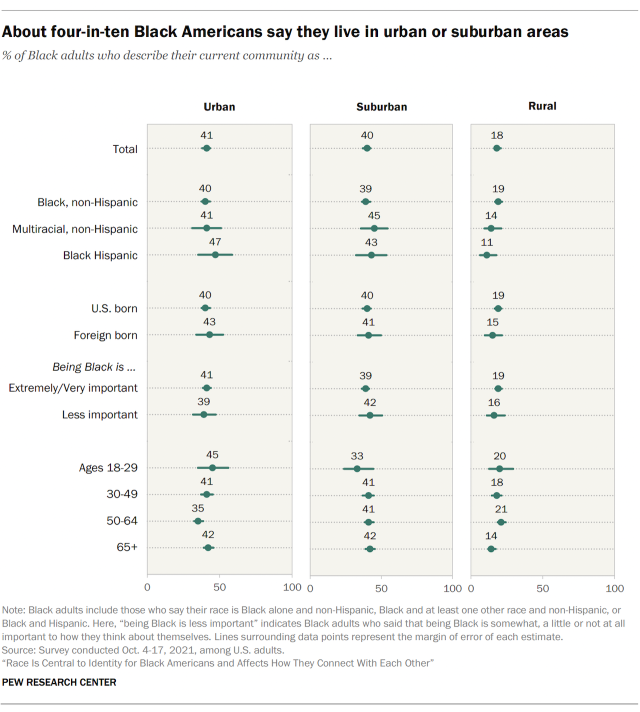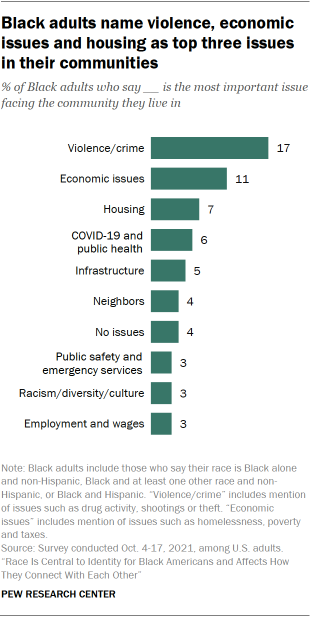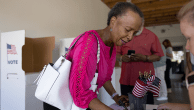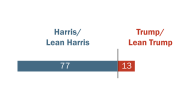Black Americans live in different types of communities across the country. For about half of Black adults (52%), the location where they currently live is important to how they think about themselves. But overall, their ratings of the places where they live are mixed. Across communities, the same concerns are cited as the most important to address – violence or crime and economic issues such as poverty and homelessness. When asked who is responsible for addressing these issues, nearly half of Black adults (48%) say local leaders should address them.
For many Black adults, where they live shapes how they think about themselves

About half (52%) of Black adults say the location where they currently live is extremely or very important to how they think about themselves. Roughly three-in-ten (29%) say where they currently live is somewhat important to their personal identity. And about one-in-five Black adults say where they live is a little or not at all important (19%) to how they think of themselves.
There are differences on this issue across some demographic subgroups. Roughly half of non-Hispanic Black adults (52%) say where they currently live is extremely or very important to how they think about themselves – making them more likely to say so than multiracial Black adults (38%). Black immigrants and U.S.-born Black adults are about equally likely to say the place where they currently live is extremely or very important to how they see their personal identity (55% and 51%, respectively).
Among Black adults who say being Black is extremely or very important to their identity, 57% say the place where they live is extremely or very important to how they think about themselves. This is significantly higher than among those who say being Black is less important to them (33%).

There are other demographic differences, too. Black women are more likely than Black men to say where they currently live is extremely or very important to how they think about themselves (56% vs. 46%). When it comes to age, adults 50 and older are more likely than those under 50 to say that where they currently live is extremely or very important to their identity (61% vs. 44%). In addition, Black Democrats and Democratic leaners (53%) are more likely than Black Republicans and Republican leaners (41%) to say the place where they live is extremely or very important to their personal identity.
The general public’s responses differ from the Black population on this measure. While about half (52%) of the Black adult population say that the location where they currently live is extremely or very important to how they think about themselves, 45% of all U.S. adults share the same view. And among the public overall, 31% say that where they currently live is somewhat important to how they think about themselves, while 23% say this is a little or not at all important.
Black adults are more likely to live in urban and suburban areas
The U.S. Black population is dispersed across the country, though over half lives in the nation’s Southern region. And within each region of the United States, the Black population is spread across various types of communities.
Roughly equal shares of Black adults describe the community where they live as urban (41%) or suburban (40%), while almost two-in-ten (18%) describe their community as rural, according to the new Pew Research Center survey.

Though similar shares of the Black population say they live in suburban and urban areas, there are differences in community type among demographic groups. Non-Hispanic Black adults are similar in their distribution to the Black adult population overall: They are about as likely to say they live in suburban (39%) and urban areas (40%), while 19% say they live in rural areas.
But the distribution of community type is different for multiracial Black adults – 45% say they live in suburban communities, while 41% say they live in urban areas and 18% say they live in rural areas. And among Black Hispanics, 52% say they are in suburban places, 40% say they are in urban areas and 14% say they live in rural areas.
A slightly higher share of U.S.-born Black adults say they live in rural areas (19%) than the share of immigrant Black adults (15%) who say the same. Both groups are about as likely to be in urban and suburban areas.

Among Black adults, men are more likely than women to describe the community they live in as urban (46% vs. 37%, respectively), while women (43%) are more likely than men (35%) to live in a suburban community.
There are differences by region as well. Black adults in the South are more likely than those in the Northeast, Midwest and West to live in a community they describe as rural. Accordingly, Black people in the Northeast, Midwest and West are more likely than those in the South to live in communities they describe as urban.
Around four-in-ten Republican or Republican-leaning and Democratic or Democratic-leaning Black adults (38% and 39%, respectively) describe the community where they live as urban. A similar pattern emerges among Democrats (39%) and Republicans (38%) who describe their community as suburban. Equal shares of Black Democrats and Republicans describe their community as rural (19% each).
There are significant differences in self-described community type by education across the Black population. Adults with a college degree or higher are more likely to live in communities they describe as suburban. Over half (56%) of Black adults with a college degree or higher say they live in a suburban community, while 34% of those who attended some college or less say the same.
There are similar differences by income level as well. Black adults with lower incomes are more likely to live in a self-described urban area than those in with upper incomes (48% vs. 25%). They are also more likely to live in rural communities than those with upper incomes (23% vs. 12%). Black adults with lower incomes are less likely than their those with upper incomes to describe their community as suburban (27% vs. 62%, respectively).
The Black population’s self-described community type differs from that of the general public. Half of U.S. adults overall describe their current community as suburban, while roughly a quarter each of that population describe their current communities as urban (23%) or rural (27%).
Most Black adults rate the quality of their community as good or better
About four-in-ten Black Americans (41%) rate their community as an excellent or very good place to live, according to the new survey. About one-third (34%) rate their community as a good place to live, while about a quarter (24%) rate their community as fair or poor. Within the Black population, community ratings vary by demographic characteristics.
Black Hispanic adults (54%) are significantly more likely than non-Hispanic Black adults (40%) to rate their community as excellent or very good. Some 47% of multiracial Black adults say the same about their community. And while roughly half (52%) of immigrant Black adults say their community is an excellent or very good place to live, four-in-ten U.S.-born Black adults say the same.

Similar shares of Black women, Black men, Black Democrats and Black Republicans rate their communities positively – about four-in-ten for each group rate the communities where they live as excellent or very good.

Community ratings also differ by education and income. Black adults with a college degree or higher are significantly more likely than Black adults without a college degree to rate their community as an excellent or very good place to live, (56% vs. 36%, respectively).
Black adults with higher incomes are 34 points more likely than those who earn lower incomes to say their community is an excellent or very good place to live (64% vs. 30%), while about half (49%) of those who are middle income share the same opinion.
Black adults who live in self-described urban areas are significantly more likely than their suburban and rural counterparts to rate the community where they live as fair or poor (35% vs. 11% and 27%, respectively). Roughly half (53%) of those in suburban communities rate their community as an excellent or very good place to live – significantly higher than the 29% who say the same in urban communities and the 42% in rural communities.
In general, Black adults rate their communities less positively than all U.S. adults. While roughly four-in-ten Black adults (41%) rate their community as excellent or very good, 58% of all U.S. adults say the same. Roughly three-in-ten U.S. adults (29%) rate their community as good, while 13% say their community is fair or poor.
Violence, the economy and housing top the list of important community issues for Black Americans

When asked in an open-ended question to identify the most important issue in the community they live in, the top issue was violence or crime (17%). This includes Black Americans who listed specific issues such as drug activity, shootings, or theft; but also those who simply listed “violence” or “crime” as the most pressing issues in their communities. Another 11% of Black adults said economic issues such homelessness, poverty and taxes were most important.
Other top issues include housing (7%), COVID-19 and public health (6%), infrastructure (5%), neighbors (4%), the availability of public safety and emergency services (3%), differences among neighbors due to racism, diversity or culture (3%), and employment and wages (3%). Some 4% did not name an issue.
The most important local issue named across demographic subgroups of Black Americans does vary. But notably, the same issues are often among the top three local issues mentioned for most groups – violence and crime, economic issues, and housing issues – even if their rankings may not be the same.
Violence or crime is the top issue for both non-Hispanic and Hispanic Black adults, but second for those who identify as multiracial. Meanwhile, multiracial Black adults mention an economy-related concern as the top issue in their community, while this ranks second among non-Hispanic and Hispanic Black adults. Housing was the third-most important community issue named by non-Hispanic and multiracial Black adults, but fifth among the Hispanic Black population.

Both U.S.-born and immigrant Black adults name violence or crime as the most important issue facing their community (17% and 15%, respectively), but the ranking of issues does not significantly differ between these two groups. Besides violence or crime, the other top issues among the U.S.-born Black population are economic issues (10%) and housing (7%). For the Black foreign-born population, the second-most mentioned issue is economic issues (11%), while COVID-19 and public health (7%) is the third-most mentioned issue.
Violence or crime is the most mentioned issue among both those who say being Black is extremely or very important to how they think about themselves (18%) and those who say being Black is not as important to how they think about themselves (13%). Economic issues are the second-most mentioned community issue for those who say being Black is very or extremely important to them (11%), but among those for whom being Black is less important, housing is the second-most mentioned issue (11%) and economic issues rank third (9%).
Views about the most important issue in their community varies by age among Black adults. Economic issues are the most mentioned among Black 18- to 29-year-old adults (15%), with violence or crime (12%) coming in second. However, those ages 18 to 29 (12%) are more likely than those ages 30 to 49 (5%) or 50 to 64 (6%) to say housing is the most important issue facing their community. The top issue for Black adults between the ages of 30 to 49, 50 to 64 and 65 and older is violence or crime (20%, 18% and 16%, respectively).
Black adults vary only slightly on this question by education and income. The top issue named by Black adults with and without a bachelor’s degree is violence or crime (14% and 18% in each respective group name this), while the issue mentioned second-most often by both groups is economic issues (12% and 10%, respectively). Black adults with a college degree or higher are less likely (14%) than those with lower educational attainment (18%) to say violence or crime is the most important issue in their community. Meanwhile, the top community issue mentioned among Black adults with lower or middle incomes is violence or crime (20% among lower income, 16% among middle income). COVID-19 and public health, violence or crime, and economic issues are tied as the issues mentioned most by Black adults with upper incomes (11% each).
There are differences by region as well. The top issue named by Black adults living in the Midwest, Northeast and South is violence or crime (24%, 20% and 15%, respectively), while economic issues and housing are the top two concerns cited by those in the West (20% and 18%, respectively). Black people in the South are also more likely than those in the other three regions to report infrastructure as the most important issue in their community.
The Black population’s rating of the most important issue facing the community they live in is only slightly different from that of the general public. Americans overall name economic issues (15%), violence or crime (12%), and COVID-19 and public health (7%) as the most important issues in their community.
Nearly half of Black Americans who name an issue important to their community say local leaders are most responsible for addressing it

When asked who is most responsible for addressing their community’s most important issue, almost half of Black adults who name such an issue say local community leaders (48%) are most responsible for addressing that issue. Smaller shares say individual people like themselves (17%), the U.S. Congress (12%), someone else (10%) or the U.S. president (5%) are responsible for solving pressing local issues.
Half of non-Hispanic Black adults (49%) point to local community leaders as the most responsible for solving the most important issue facing their community, with multiracial and Black Hispanic adults being about as likely to say the same. And roughly half (49%) of U.S.-born Black adults and four-in-ten Black immigrants who named a local issue say local leaders should be most responsible for addressing the most important issue in their community.
Answers did not vary much, if at all, based on how important Blackness was to each respondent. Of the adults who named a local issue, those who say being Black is extremely or very important to how they think about themselves are about as likely as those who say being Black is less important to how they think about themselves to say local community leaders are most responsible for addressing the most important issue in the community they live in (50% and 44%, respectively).
While four-in-ten or more of both Black Republicans and Republican leaners (40%) and Black Democrats and Democratic leaners (50%) say local community leaders should be most responsible, there are differences by party when it comes to naming civil rights organizations. Black Republicans are significantly more likely than Black Democrats to say civil rights organizations are most responsible for addressing the most important issue in their community (8% vs. 1%).
Somewhat similar shares of Black adults in self-described urban, suburban and rural communities name local community leaders as most responsible (46%, 50% and 52%, respectively). Black adults in rural communities are less likely than those in urban communities to name Congress as most responsible for addressing the most important issue in their community (8% vs. 14%).
Black adults in the South are more likely than those in the Midwest and West to say that local community leaders are most responsible for addressing this community issue (53% vs. 42% and 40%, respectively). Around half (49%) in the Northeast point to community leaders as most responsible as well. Black adults in the West and Northeast (23% and 16%, respectively) are more likely than those in the Midwest (8%) and South (9%) to say Congress is most responsible for addressing the most important issue in their community.
Answers to this question differ by education and income among the Black population. Black adults with a bachelor’s degree or higher are more likely than those without a degree to say local community leaders are most responsible (54% vs. 46%). About half or more of Black adults in middle- and upper-income tiers say local community leaders should be most responsible for addressing this issue (52% and 56%, respectively), significantly more than those in the lower-income tier (44%).
Black Americans who named violence or crime, economic issues, or housing as the most important issue in their neighborhoods are still most likely to say that local leaders should be responsible for addressing those issues. However, among those who name economic issues as most important, almost three-in-ten (29%) say Congress is most responsible. And among those who name housing as the most important issue in their neighborhoods, roughly one-in-five say Congress (21%) should be responsible.
The general public and Black population’s responses to this question are somewhat similar. Half of U.S. adults overall say that local community leaders should be most responsible for addressing the most important issue in their community, while 16% point to individual people, 13% point to Congress and 10% point to someone else as most responsible.




